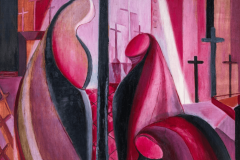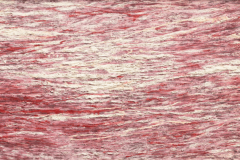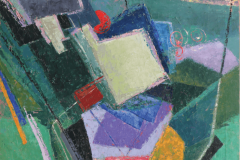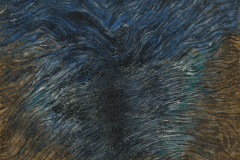Buying Nena Saguil paintings – Highest Prices Paid: Artist Bio & images follow:
SIMPLICIA “NENA” LACONICO SAGUIL
a.k.a. Nena Saguil (b. Manila, September 19, 1914, d. Paris, February 1994)
Nena Saguill, a pioneering Philippine modern artist remembered as a feminist, a mystic and a recluse, was one of ten children of Epifanio Saguil and Remedios Laconico. Saguil later spoke of having been a lonely child at a crowded dinner table. Her father Don Epifanio Saguil was a medical doctor who served as the personal physician of the Philippine President Manuel L. Quezon. Later in life Saguil claimed to have been born in 1924, but research has confirmed that she was born in 1914.
Not wanting to attend Catholic school, as her conservative parents wished her to, Saguil studied art at the University of the Philippines School of Fine Arts where artist Anita Magsaysay was a classmate. Saguil was awarded a certificate in painting in 1933. The school was then considered a bastion of conservatism in art, and Saguil later told a friend what she thought of some of the instructors there: Fernando Amorosolo was a very commercial artist and Fabian De La Rosa was not a very good painter.
After the disruptions of World War II Saguil was able to complete her studies at the University of the Philippines, where she found herself connected with Hernando Ocampo and his many artist friends. During this period Saguil became increasingly interested in modern art was attracted to the work of Pablo Picasso. She completed her Bachelors Degree in 1949, earning an Award of Excellence. Her works of this period include a satirical self portrait entitled Vanity, and number of floral still lifes painted with a light, Impressionist touch.
Around 1950 Saguil became active in the newly formed Philippine Art Gallery (P.A.G.) run by Lyd Arguilla. Because her parents owned some property that provided her with income Saguil did not have to work and was able to devote time to her art. In the afternoons she served as a volunteer, watching over the P.A.G. Gallery. Through her connection to the P.A.G. Saguil exhibited with and became associated with other notable Philippine early modernists including Vicente Manansala, Romeo Tabuena, Fernando Zobel, Arturo Luz, Hernando R. Ocampo and Anita Magsaysay-Ho.
Saguil paintings of the 1950s include Cubist renditions of traditional Philippine subject matter, such as rice planting, as well as more rebellious Surrealist works. Her 1953 oil Power Room, in the Paulino and Hetty Que Collection, features a toilet-headed figure wielding a plunger and a whip in a tiled bathroom setting embellished with coils of human waste.
In 1954, at the age of forty, a Walter Damrosch Scholarship allowed Saguil to move to Spain, where she studied abstract painting. Another scholarship, from the Instituto de Cultura Hispania allowed her to further her studies. In 1956 Saguil moved to Paris to further her studies at the Ecole des Artes Americane. The following year Saguil had a solo show at Galerie Raymond Creuze in Paris, where she exhibited works with linear and geometric elements. She later experimented with a syringe technique similar to that of Fernando Zobel and Lee Aguinaldo, painting delicate loops and spatters on softly brushed grounds. Saguil also sold a few Paris scenes in a style similar to that of Raoul Dufy to earn extra cash.
Saguil, now isolated from the Philippine art scene, lived in solitude in a dingy apartment in the Saint Germain des Pres district, sometimes working as a maid to support herself. She had lived and worked in Paris for over a decade before coming back to Manila for a retrospective exhibition at the new Solidaridad Galleries in 1968, bringing over 200 works with her. By the end of her career she had also taken part in exhibitions in Germany, Italy, England, Switzerland, Sweden, Turkey, and the United States.
Nena Saguils mature abstract works are often described as cosmos and many contain spheres, fibers, dots, vortices and bubbles. Her imagery has also been characterized as cellular, and some of her forms appear as if seen through a microscope. Saguil was a Jehovahs Witness in her later decades, and her work often contains a sense of spirituality and religious feeling.
After her death in 1994 Saguil was the subject of a September 1995 memorial exhibition at the at the Lopez Museum which was followed by a major exhibit at the Cultural Center of the Philippines in 1997. In 2003, Nena Saguil, Landscapes and Inscapes, from the Material World to the Spiritual was presented at the Ateneo Art Gallery, accompanied by a catalog written by Emmanuel (Eric) Torres. In 2006 Philippine President Arroyo posthumously awarded Saguil a Presidential Medal of Merit.
Do you have artwork by this artist that you are interested in evaluating or selling?
INQUIRE ABOUT YOUR ARTWORK



